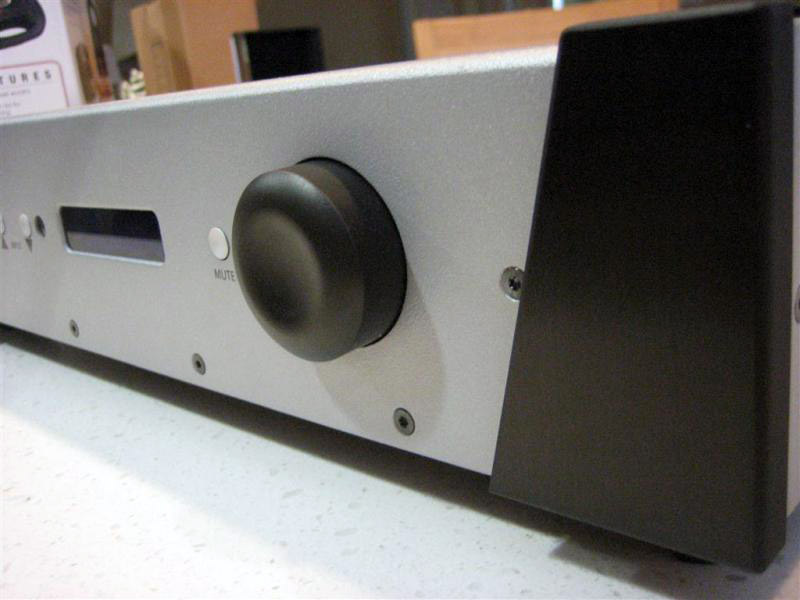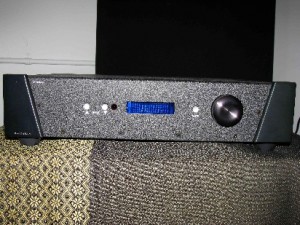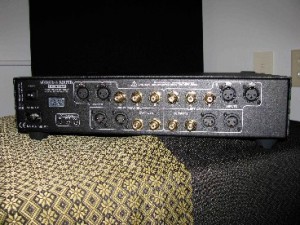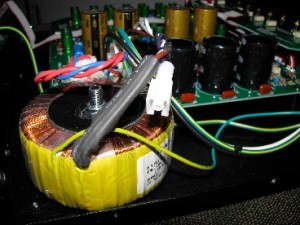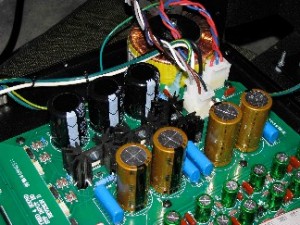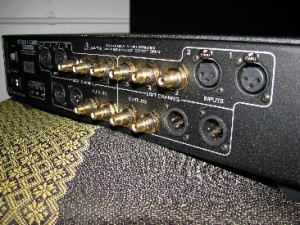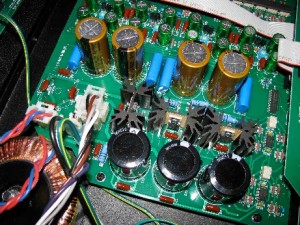Specifications:
- Typical Distortion
- THD+N (20-20kHz / 2V) <0.003%
- THD+N Noise (A-weighted / VOL = 63) < 6 µV
- Noise (A-weighted / VOL = 64) < 18 µV
- Noise (20-20kHz / VOL = 63) < 9 µV Noise (20-20kHz / VOL = 64) < 27 µV
- Frequency Response (20-20kHz / 2V) +/- 0.02 db
- Channel Tracking (All Steps) < +/- 0.05 db IMD < 0.002%
- Crosstalk (20-20kHz / VOL = 63) >106 db
- Crosstalk (20-20kHz / VOL = 64) > 96 db
- Output Impedance (VOL ? 63) 113 Ù
- Output Impedance (VOL ? 64) 78 Ù
- Input Impedance 60.4kÙ
- Maximum Output Voltage 9V RMS
- *Vol = 63 (gain stage not engaged)
- *Vol = 64 (gain stage engaged)
- Manufacturer: Cullen Circuits
The Introduction:
Hobbies are often a costly investment. The best hobbies waste time like a college student and money like a Congressman. The time and money spent is accompanied by a round sense of gratification with a dull sense of pain . . . with the latter usually the next morning. Audio is no different. Beautiful music is a pleasure that keeps me up late and lets me dream so sweet. However, if I’m going to continue living the dream, I need to make sensible audio investments.
An audio-investor looking to direct funds towards a solid product is instinctively attracted to strong brands that possess prestige, impeccable customer support, and lots of cash for R&D. Naturally, these companies through years of advancement in the industry are seemingly well positioned to deliver the best sounding and most innovative products. With traditions of rock-steady performance, legendary brands such as Esoteric, McIntosh, Krell and B&W attract consumers dedicated to the best musical reproduction. These “audiophiles” are prepared to throw down gobs of cash to make a classic tune sound even better, and usually they succeed.
Unfortunately in these uncertain economic times, few of us have a home to mortgage to purchase hi-fidelity gear. As a solution to this dilemma, E.J. Sarmento began Wyred4Sound (“W4S”) to deliver cutting-edge products direct from the manufacturer at prices that won’t require a bailout later. Mr. Sarmento introduced W4S with assistance from Rick Cullen, business partner and founder of Cullen Circuits. Since 1990, Cullen Circuits helped develop and manufacture notable brands such as PS Audio, Genesis Technologies, and numerous others before those companies relocated manufacturing to China. Today, as an example of American adaptability and in an effort to maintain American manufacturing, Cullen Circuits assembles W4S products in California.
It stands to note, Mr. Sarmento does not have a name like Paul McGowan. W4S has yet to make history like PS Audio. But, by the leadership of Rick Cullen and the innovation of E.J. Sarmento, Cullen Circuits boasts a remarkable reputation of manufacturing revolutionary audio gear for nearly the last twenty years.
Wyred4Sound STP SE review
The Features:
The “STP SE” is short for Stereo Preamp – Special Edition. The SE edition may cost $200 more than the standard STP, but the upgrade includes Kimber Tcss, multi-gauge, multistrand, continuous strand pure copper for the input/output stages as well as W4S Low ESR “Super Caps” for the power supply capacitors. W4S claims on its website that these improvements offer improved 3-D imaging and instrument placement. I’ve never heard the standard edition to offer a comparison, and I don’t really intend to ever. I wouldn’t be surprised to see the standard edition phased out over time. And, why not? At $1,799 a pop, what’s two hundred more bucks?
Now before we go any further, it’s important to realize what kind of reviewer you are dealing with here. I’m at best an intellectual, and at worst a law clerk studying to be an attorney. Anything I know about this hobby, I’ve learned through experience by sticking my finger in the outlet and flipping the switch. Consequently, I can’t explain to you how the STP SE is both passive and active, but I do know this means the STP SE is intended to output ultra clean sound, and then have the ability to push it even harder long after your ear drums have ruptured.
In an effort to receive an education, I set out to examine the STP SE both inside and out. A look at the unit’s rear reveals two pairs of balanced inputs and outputs, which I am happy to report are fully balanced. In addition, there are two pairs of single-ended outputs, three pairs of single-ended inputs, and a programmable DC trigger for HT bypass. Directing my intention towards the guts of the unit, it took an entire episode of Southpark to unscrew the 23 socket screws and detach a couple cables to comfortably slide the top cover off the chassis. Maneuvering the unit up and around to remove all the screws permitted me to confirm the STP SE easily passes the traditional “weight=quality test.”
Beneath the hood revealed a short network of circuits that are instantly overshadowed by massive black barrels or 164,560+uF of capacitance to be exact. The STP SE with its oversized transformer and capacitance in the hundreds of thousands looked more like a mammoth amplifier on the inside than a passive preamp of all things. Evidently, the considerable capacitance is part of W4S’s proprietary Triple-Ripple-Reduction power supply circuit, which in the real word means “clean, quiet power” to spare.
Finally, the STP SE remote is a light but well designed piece. It permits precision volume control, balancing, power switching, absolute phase adjustment and, perhaps most welcome, a completely dimmable display. Aside from the simple controls on the remote, the preamp also permits input naming and selection of an HT bypass via the controls on the unit’s face. This is accomplished by pressing the volume knob and an input button simultaneously to unlock the menu system for naming and assigning inputs. The menu system is simple to navigate once you click through it a few times. The preamp displays information via an unfortunately tiny display screen on the faceplate. Users with poorer vision might have issues seeing changes in volume or adjusting the unit from the distance of their listening positions. Fortunately, the screen is incredibly clear so perhaps only the most senior A$$A readers will take issue.
The Sound:
After receiving the W4S STP SE, I reluctantly disconnected my BAT VK-3ix SE (with the beloved Russian 6H30 Super-tubes) and replaced it with the STP SE for a 200 hour workout with the Isotek Full System Enhance break-in disc. Returning in the evening a few days later, I settled into the fold of my listening chair unsure of what to expect from a preamplifier without tubes. Don’t get me wrong, I like solid-state gear; however, I prefer my amps to be SS, and my preamps to be tubed.
My first dedicated preamp was a Rogue Audio Metis. The Metis had rockin’ bass, but was tormented by a high noise floor that stole detail from most tracks and made solo or quiet pieces almost unlistenable. Fortunately, the Metis permitted easy access to change tubes, which made experimenting with different tubes to mitigate the preamps inherent weakness very convenient.
The Odyssey Candela, an excellent piece crafted by Klaus Bunge, was my second preamp and successful upgrade that cured most weaknesses of the Metis. The Odyssey had a leaner lower end, perhaps less augmented and more natural in retrospect with a noticeably lower noise floor. For the money, the Odyssey midrange was excellent, however, acoustic guitars and other stringed instruments didn’t quite have the proper grit on the strings like I was hearing from more expensive preamps.
To further address the weaknesses that lingered in my system even after the Odyssey upgrade, Walter Liederman of Underwood HiFi introduced me to a product by Gary Dodd of Dodd Audio that would change the way I listened to music. The Dodd Battery Powered Tube Preamp was my first experience of truly feeling and seeing the performance in my living room. The clean battery power of the Dodd reduced the noise floor of my system to all but a welcoming tubey hiss from my tweeters that could only be heard from a few feet away. The Dodd was capable of an effortless midrange that simply took my breath away. And, in all its gentle simplicity as it operated without a plug in the wall, the Dodd could ignite the room with dynamics that swelled through your veins like the first time you kissed a beautiful girl goodnight.
Finally, my BAT lacked the slightly romantic presentation of the Dodd, but revealed details in the recording simply glossed over by lesser units. The BAT was just as quiet as the Dodd with a decidedly more vivid and taught presentation. Whereas the Dodd added a touch of blush to tie each note together, the BAT delineated from which instrument each note entered the room. The BAT revealed the sweat on a singer’s brow that came before the quiver in her voice as she left her training behind and remembered the emotion that inspired her to write the song in the first place. The Dodd and the BAT were equals and yet completely different lovers.
So now to the question at hand, how does a $1,999 preamp sound? The W4S is ballsy as hell . . . Listening to “Bottom” by Tool from their album “Undertow”, the intro of the song strikes with a punishing arrangement of power chords that would only fail to pump-up the comatose. At a point during the first thirteen seconds of the song a short pause in the riffs gives way to the decay of the distorting guitar. In this moment you take a breath before the electric guitar rips back into center stage with a voluptuously tight low-end growl and deep rhythmic attack. It should be noted that the W4S does not at all artificially inflate the lower registers. By my estimate the STP SE simply allows the natural full range of the song to be heard.
As the hidden track of “Undertow” completes the final seconds of the album with the humorous murmurs of sheep bleating while unknowingly being led to slaughter, I couldn’t help but recognize the opportunity to listen to another wonderful song, “Ants Marching” by Dave Matthews and Tim Reynolds: Live at Luther College. This entire album is an excellent example of well-recorded live rock music. Each musician and his instrument is captured and arranged across the stage with incredible realism. And, I am happy to report that the STP SE conveyed every acoustic note on the album with all the bluesy rapture of the live experience. In particular, Tim Reynolds redefines the term “vibrato” with his aggressive yet graceful mastery of the acoustic guitar in the song “Stream”.
Hearing Dave for the first time with this alien preamp, I bit my tongue as Mr. Reynolds settled in for his solo performance . . . and then it happened: the singular strum of an acoustic guitar’s strings followed by the whisk of the musician’s fingers brushing up the tuned metal until finally the notes sizzled on the fret board. In that moment, I knew I had my midrange. The absolutely transparent presentation was not sterile or tame as some passives are afflicted. Instead, the STP SE allowed the color of the performance to be heard vividly without adding any tone of its own.
Dispensing with the heavy metal and rock music, I grabbed my iPod Touch and directed my MacMini to play something more civilized, the 24/96 high-resolution album Mirror Canon by Tor Espen Aspaas. The voice of a female singer in this album left me entranced. I was immovable as the timbre of accompanying violins elevated the emotion of her voice to a level I’ve only ever heard from valve preamplifiers. Moreover, amid the quietest moments of this album, where a lonely violin played an eerie note back and forth across the soundstage, I took note of the absolute silence of the background. Utter quiet. The total absence of valve hiss made the spooky portion of the album that much more “disquieting.”
For my final test, I asked Ms. Mary Stallings to join my listening session. With just two clicks she of course obliged and began singing “For All We Know” from her album Fine and Mellow. Clarity Records produced this masterpiece with just two microphones set before Ms. Stallings and her band in what was virtually a live performance.
Mary’s voice is a canvas of sweet pain born out of life’s experiences. When you hear her instrument properly it should invoke the subtle strength that comes with the wisdom of growing old and the sadness of knowing our time here is temporary. The STP SE stepped aside and allowed the aforementioned to solidify before me as Mary told the tale of making every moment of love count. Each verse of this song played through the STP SE with uncanny accuracy. And yet without a single glowing tube, the recording retained its pleasantly warm presentation.
The Conclusion:
I’m not sure what else I can tell you that you haven’t already gathered for yourself. To say my experience with the STP SE was mind-blowing would be an understatement. E.J. Sarmento and the gang at Cullen Circuits have truly outdone themselves. It’s undeniable my W4S amplifiers added to the STP SE’s synergy in my system. However, synergy aside, its virtually unspeakable in the audiophile world to say a tubeless preamplifier possesses all the smooth and inviting characteristics of the most modern and affordable valve units, while at the same time raising the standards of what’s expected from a sub-$2k preamplifier to new stratospheric heights. But, that is exactly what I am saying.
Review Equipment:
- Apple MacMini (AIFF files) iPod Touch (iTunes remote) Peachtree Nova DAC
- HRT Music Streamer+ Wyred4Sound STP SE
- Behringer DCX24/96 w/ Cullen Circuits Mods (external crossover for EP CS2) Dodd Audio Levitator
- Wyred4Sound ST-250/500 (Pair) w/ Nikolas812 Custom Paint Job
- Emerald Physics CS2.3
- MAC CuQ Speaker Cables
- MIT Shotgun S3 Pro-Line/RCA Interconnects
- Signal Cable Magic
- Digital Power Cords
- VTI Audio Rack (filled w/ lead shot) PS Audio Quintet
 from affordableaudio, By Michael Cooke
from affordableaudio, By Michael Cooke
